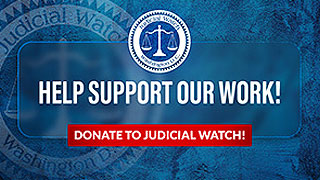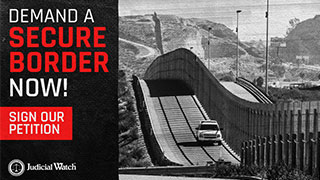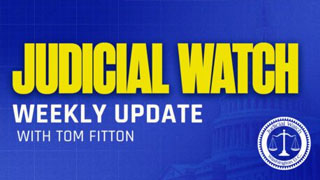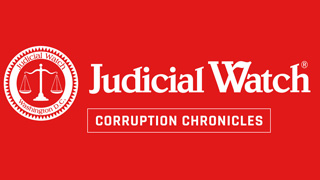
Killing Cardillo: What Did The FBI Know And When Did They Know It?
Yesterday, the New York Post ran my investigative report on a very cold case: the mortal wounding of NYPD Patrolman Phillip Cardillo inside Louis Farrakhan’s Nation of Islam Mosque #7 in Harlem in April, 1972. The “Harlem Mosque Incident” would become one of the most controversial cases in NYPD history—a tale of betrayal and cover-up, race and politics, played out across a disintegrating city.
I’m grateful to the Post for getting behind a story that raises the disturbing possibility that the FBI was deeply involved in the events surrounding Cardillo’s death. Due to space limitations at the newspaper, some of the supporting material had to be cut. Judicial Watch’s Investigative Bulletin is posting the story here in full. If the Post’s terrific version was enough for you, stop here. If you want more—and with apologies for some overlap between the two—read on.
Exactly 43 years ago today—on April 20, 1972—Phillip Cardillo died in St. Luke’s Hospital in New York, six days after being shot inside the mosque. It was a strange and violent time, when New York and the nation found itself at war not just in Vietnam but on its own streets. Racial tensions were running high. Urban homicide rates had skyrocketed. Radical groups like the Weather Underground and the Black Panther Party were trying to stoke a revolutionary fury in the streets with bombings, murder and mayhem. In New York, an ambitious liberal mayor, John Lindsay, was eyeing a run for the presidency.
In a string of brutal crimes directed against the NYPD, officers Thomas Curry and Nicholas Binetti had been blasted with machine-gun fire as they guarded the home of Manhattan DA Frank Hogan. Officers Gregory Foster and Rocco Laurie were murdered on the Lower East Side, shot from behind. Officers Joseph Piagentini and Waverly Jones were shot to death outside a Harlem housing project. Radicals associated with the violent Black Panther Party and Black Liberation Army were fingered for the crimes.
Then came the shooting at Mosque #7. At the time, mosque leader Louis Farrakhan was in the building. Congressman Charles Rangel arrived within an hour. A young police officer named Raymond Kelly—later to become one of New York’s most storied police commissioners—was one of the guards at the hospital where Cardillo died.
Farrakhan, Rangel, Kelly—all would play important roles in the Cardillo case. All have ignored repeated requests by many journalists through the years, including this reporter, to discuss it.
And death was only the beginning of Phil Cardillo’s troubles. The city’s political establishment turned its back on him, a cop killed in the line of duty. The mayor and police commissioner did not attend his funeral, fearing a political backlash in the African-American community and bad press for the Lindsay’s presidential ambitions. The NYPD rank and file was outraged and to this day “Remember Cardillo” is police byword for the perfidy of the political establishment. NYPD brass threw Cardillo under the bus. A special prosecutor later concluded there was an “orchestrated effort” by members of the NYPD “to impede” the Cardillo murder probe.
No one was ever convicted in the killing. “It’s the only homicide of a police officer in New York City in the last 43 years that has not been solved,” says police historian Mike Bosak.
More than four decades later, controversy still shadows the Cardillo case.
In 2006, then-Police Commissioner Ray Kelly ordered a new investigation by the NYPD Major Case Squad. According to 2006 letter from the NYPD to the FBI, the new investigation had been launched “to determine if there is evidence of a conspiracy in 1972” to kill Cardillo. That investigation has dragged on for nine years. Sources tell me there has been no genuine cooperation from the FBI. As late as 2012, a Cardillo cousin circulated a memo saying that the Major Case Squad assured him the investigation was still “active.”
An attempt to name a small street in Harlem after Cardillo hit the rocks in 2013 when the local community board ruled that the police must first get permission from two local mosques—including the one where Cardillo was shot. In an angry letter to Kelly, Cardillo’s son, Todd, called the decision “a slap in the face to me and my family.”
In 2014, media reports said that Cardillo would finally be commemorated with a street named for him outside the new Police Academy and an NYPD patrol boat christened in his honor—but so far, nothing.
For two years, I’ve been digging among the ruins of the Cardillo case. What happened that day at Mosque #7? Why does every attempt to get justice for a slain cop—the initial police investigation, the second police investigation, the secret police investigation, the two trials of an alleged shooter, the grand jury probe by a special prosecutor, the efforts of former detectives and prosecutors—seem to vanish down the memory hole?
Memory, of course, is elusive. Documents less so. The story the documents tell about the Cardillo killing include:
–According to a White House tape, concern about cop killings in New York went all the way to the Oval Office, where President Richard Nixon and FBI Director J. Edgar Hoover launched a secret program to hunt down the murderers.
— A secret NYPD report on the killing, known as the Blue Book, was withheld from the department’s own investigators and from prosecutors in the Manhattan DA’s office.
–A long-forgotten special prosecutor report on the case, buried in state archives for 30 years, raises questions about obstruction of justice.
–FBI documents reveal the existence of high-level Nation of Islam informants and hint at possible dirty tricks at the center of the case.
The ultimate question: can this cold case be solved?
The answers are back in 1972.
*
It began at 11:41 a.m., April 14, 1972. A “10-13” call came in to the NYPD Communication Division. A 10-13 is every cop’s worst nightmare, a red alert meaning “officer in distress.” The call was taped.
“Hello, this is Detective Thomas of the 28th Precinct,” the caller said. “I have a 10-13 [at] 102 West 116th Street.”
In fact, there was an actual Detective Thomas working at the 28th Precinct. But the caller was not Detective Thomas. The caller has never been identified.
The police operator repeated the address. He did not know—and “Detective Thomas” did not offer—that 102 West 116th Street was the home of Muhammed Mosque #7 of the Nation of Islam.
“Right,” said the man posing as Detective Thomas. “That’s on the second floor.”
The second floor of the mosque housed classrooms, where lessons were ending. On the third floor was the prayer hall and the office of the mosque leader, Minister Farrakhan.
Cardillo and his partner, Vito Navarra, were the first cops on the scene. The mosque doors, usually bolted shut and manned by the Nation of Islam’s own para-military force, the Fruit of Islam, were unlocked and unguarded.
Two mysteries have haunted the Cardillo case for four decades. Who made the fake 10-13 call drawing the NYPD to the mosque? And why were Nation of Islam guards not stationed at the mosque doors?
In the reception area, Cardillo and Navarra encountered six men. Navarra darted up the stairs. Somewhere up on the second floor, he believed, a brother officer was in serious trouble. He was met by ten men who forced him back down the stairs. Nine more cops rushed into the reception area. A fight broke out.
All but three of the cops were forced from the mosque and the metal doors were slammed shut and locked. Cardillo and two other cops were left inside, consumed in a fierce struggle. At 11:45—less than five minutes after the fake 10-13 call—police radios reported an ominous new development: shots fired.
*
Recently uncovered documents make a detailed reconstruction of the Cardillo case possible. A year after the shooting, a secret internal NYPD review was conducted. Known as “the Blue Book” for its original blue cover, it was never made public, although in 1983 the newspaper Newsday disclosed its existence. A grand jury investigation and report by special state prosecutor also pieced together the Cardillo affair.
Yesterday, the Post published the Blue Book on its website. Next week, Judicial Watch will post the special prosecutor report and related documents.
As cops forced their way back into the mosque, Cardillo and another officer were found “lying on the floor, both bloodied,” the Blue Book said. Cardillo had “received a gunshot wound of his right side during this attack, the bullet exiting from his left side.”
Police were now pouring into the mosque. Some of them pursued a “fleeing group into the basement, where approximately sixteen [men] were located, frisked and detained,” the Blue Book said. The special prosecutor report added, “a few of these men had blood on their clothes.”
“Blood evidence is very important,” said retired NYPD detective Nick Cirillo, one of the lead investigators on the Cardillo case. “It can put suspects at the scene.”
But outside the mosque, the situation was unraveling fast. “The situation in the street deteriorated …to the point of potential riot,” the Blue Book said. A crowd had gathered, bricks were hurled from rooftops, vehicles were overturned and burned.
Inside the mosque, the scene was chaotic. In the basement, the sixteen suspects “refused to answer questions and refused to identify themselves,” according to the Blue Book. Then Louis Farrakhan and Charles Rangel appeared.
“With the arrival of Minister Farrakhan and Congressman Charles Rangel,” the Blue Book said, “other Muslims entered the basement and started screaming invectives at the officers and demanded the removal of all police officers from the mosque.”
A high-ranking officer at the scene, Chief of Detectives Albert Seedman, took charge.
Seedman said little about events in the basement for decades. He resigned soon after the mosque incident. But in a 2011 preface to a new edition of his book, “Chief! Classic Cases from the Files of the Chief of Detectives,” he described what happened next.
Seedman said Rangel told him: “That crowd upstairs, they know you’re down here. I don’t know how long it will be before they come down. If you don’t leave now, I can’t guarantee your personal safety.”
Seedman was unfazed. He called in a request for back-up. The NYPD had detailed plans to handle urban unrest. He was stunned by the response: request denied.
Seedman said a superior officer “made it clear to me that we should abandon the mosque in order to minimize the threat of a possible riot.”
Seedman said he made a deal with Rangel: the NYPD would leave the mosque if Rangel promised to deliver the suspects to a local police station that afternoon. Rangel agreed. The NYPD withdrew from the mosque, leaving behind the crime scene, blood and ballistics evidence, and sixteen suspects.
Rangel and the suspects never showed up.
Rangel has denied Seedman’s version of the events, but has never offered his own. He did not respond to interview requests.
In 2006, one of the lead detectives on the Cardillo murder, Randy Jurgensen, published “Circle of Six,” a hard-hitting book on the case. Jurgensen wrote that as the police exited the building, mosque members were “mopping up the blood.” The crime scene “was being erased with every stroke of the mop.”
Meanwhile, NYPD brass issued another controversial order. According to the special prosecutor report, “a command decision was made to remove white police officers from the area.”
The assembled cops were “dumbfounded,” Jurgensen wrote. “We were no longer men in blue. Now we were stripped bare by a high-ranking police official under orders, stripped of our brethren and stripped of our unity.” The special prosecutor report concluded that “morale of both black and white officers was damaged” by the order.
*
Phil Cardillo was dead, but for detectives trying to find his killer, thenightmare was just beginning. The crime scene was gone, the witnesses were in the wind.
In 1973, Jurgensen took over the case. Decades later, in “Circle of Six,” he would accuse members of the city’s political and police establishment of a “purposeful negligence of duty” in the Cardillo affair.
The grand jury led by the special prosecutor came to the same conclusion. “In the opinion of this grand jury,” it noted in its final report, “there has been a concerted and orchestrated effort by members and former members of the Police Department to impede the investigation into the murder of Patrolman Philip Cardillo. It is our opinion that there has also been an effort to impede our investigation into the events which followed the murder of Patrolman Cardillo.”
The Blue Book plays a key role in the case. Completed in 1973, the secret NYPD internal report—it’s official title is “Report and Analysis of the Muslim Mosque Incident of April 14, 1972”—is a detailed reconstruction of the Cardillo shooting and aftermath, with witness interviews, names of suspects, investigative leads, and a ballistics report.
But detectives who worked the Cardillo case say they never saw the Blue Book. It was withheld from the police department’s own investigators. According the report of the special prosecutor, “the Blue Book was only circulated within the upper ranks of the Police Department.”
“We never saw the Blue Book,” said Cirillo, the former NYPD detective who worked the case. “Of course it would have been important.”
“It had leads, it had witness names and a ballistics report,” said Jurgensen. “It would have been hugely important to our investigation. I never saw it.”
The Blue Book also appears to have been withheld from prosecutors at the Manhattan DA’s office.
In the summer of 1976, Lewis 17X Dupree, a Nation of Islam member who was at the mosque on the day of the shooting, went on trial for Cardillo’s murder. The trial resulted in a hung jury. In a second trial, Mr. Dupree, who now uses the name Khalid Elamin Ali, was acquitted.
The special prosecutor report says the Blue Book was “forwarded” to the Manhattan District Attorney “early in 1976”—three years after it was completed and on the eve of Mr. Dupree’s first trial. But two prosecutors who worked the case say that is not true.
James Harmon was the lead prosecutor in both Dupree trials. “I do not have any recollection of ever seeing the Blue Book,” he said in a recent interview.
“I never saw the Blue Book,” said John Van Lindt, the first prosecutor to be assigned to the Cardillo case. “It’s outrageous that the NYPD would conduct a parallel investigation and not tell anyone.”
Jurgensen was assigned to the elite DA’s detective squad handling the high profile case. “I am absolutely sure we never received the Blue Book,” Jurgensen said. “I saw every piece of paper that went through that office related to the case.”
The records of the special prosecutor are sealed under grand jury law. Barring a court order, it is not possible to determine who told the special prosecutor that the Blue Book was “forwarded” to the Manhattan DA.
*
New details have also surfaced about another player in the Cardillo case: the FBI.
According to documents, the FBI knew a lot about the suspected killer, Dupree, and the Nation of Islam. But little of that information reached New York detectives and prosecutors.
“We know now, in 2015, that the FBI had a lot more information about the Cardillo case in the 1970s than it was providing to us at the time,” said Jurgensen.
In the 1960s and 1970s, the FBI was at war with America’s domestic enemies, real and imagined. The FBI’s secret COINTELPRO counter-intelligence program tried to disrupt and discredit many groups, including what FBI documents from the time refer to as “black extremists”—a broad category of targets ranging from the Nation of Islam to the non-violent Southern Christian Leadership Conference and the revolution-preaching Black Panther Party.
Concern about “black extremists” went right to the top of the U.S. government—to President Nixon and FBI Director Hoover. The COINTELPRO program was unmasked in 1971 and ordered closed down. But Nixon and Hoover directed that another secret program be launched in New York in response to the assassinations of police officers.
“I don’t think people today can appreciate the amount of violence that was directed toward the police during that era, from 1970 to 1975,” said former prosecutor Van Lindt. “There were a lot of policemen killed, cold-blooded murder in the streets.”
In an extraordinary conversation recorded by the White House taping system and released by the Nixon Library, Nixon and Hoover discuss the brutal May 1971 assassination of New York City police officers Waverly Jones and Joseph Piagentini, gunned down in a Harlem ambush. The Post put it up on their website yesterday. You can hear it here.
“By God, let’s get these bastards,” Nixon said to Hoover.
“I’ll go all out on the intelligence on this thing,” Hoover said.
“Go in with everything you’ve got,” Nixon said. “Surveillance, electronic and everything.”
The result, as T.J. English reported in his book, “The Savage City,” was a new joint effort by the FBI and the NYPD: Operation Newkill.
Operation Newkill “would be devoted solely to seeking out and taking down anyone even peripherally involved in the police shootings,” English wrote. “The NYPD liaison was Chief of Detectives Albert Seedman”—the same high-ranking NYPD official who would later take charge of the Cardillo case.
FBI resources would be poured into the NYPD, English reported. In return, Hoover demanded only one condition: complete secrecy. “The FBI’s involvement would never be acknowledged,” English wrote.
It was in this atmosphere—violent, paranoid, secretive, the city on the edge of chaos—that Cardillo was killed.
The day of the Cardillo shooting, prosecutor Van Lindt noticed two FBI agents at the 24th Precinct Station House, where Dupree and another suspect had been brought on assault charges related to the mosque melee.
“What was the FBI doing there?” Van Lindt said. “It was a police shooting. There were no federal charges. It was very unusual.”
Van Lindt said the FBI agents were “sitting there with a Rolodex of photographs.” Van Lindt introduced himself. “They said they were here to help. I never saw them again.”
In 2006, James Harmon—the former lead trial attorney in the Dupree prosecutions—raised questions about the FBI’s role in the case.
In a letter to Police Commissioner Kelly, Harmon cited Van Lindt’s encounter and two other instances the day of the shooting when police officers reported sightings of Dupree in the presence of FBI agents: at Harlem Hospital, where Dupree had been taken for treatment of minor injuries, and “in the backseat of the police car” transporting Dupree.
“This FBI presence was highly unusual and remains unexplained,” Harmon wrote.
Confidential FBI documents and COINTELPRO memos released under the Freedom of Information Act also raise questions about the extent of the FBI’s involvement in the Cardillo affair.
One COINTELPRO tactic was the use of anonymous or “pretext” phone calls—FBI agents posing as someone else—to disrupt targeted groups. A February 1968 COINTELPRO memo from the FBI’s New York field office to headquarters seeks permission to make “anonymous and other pretext phone calls…to neutralize and frustrate the activities of these black nationalists.”
Six targets are noted in the memo. Four of the names have been blacked out by FBI censors. The FBI did not respond to requests for an unredacted copy of the memo.
“Could that fake 10-13 call sending cops to the mosque have been an FBI ‘pretext call’ gone terribly wrong?” asks Jurgensen. “Or could the FBI have had a high-level informant inside the mosque who was somehow involved and has been protected all these years? I don’t know. Only the FBI knows. But look at the Whitey Bulger case in Boston—there’s a situation where an individual was both a killer and an FBI informant.”
Two COINTELPRO memos note the presence of “high-level NOI [Nation of Islam] informants” and “top-level sources” in the Nation of Islam.
In addition, a never-before-seen confidential FBI report on Dupree, written two months after the shooting, lists six “informants” related to the case. All the names are blacked out. Disclosure of sources, the memo noted, could “adversely effect the national defense interest of the U.S.” Judicial Watch is releasing the FBI report next week.
The confidential report shows that the FBI had kept close tabs on Dupree for years . It noted that although Dupree had “no official position” in the Nation of Islam, he held a number of jobs, including “driving Louis Farrakhan, minister in charge of Mosque #7.”
The report noted that Dupree was a “current member” of Mosque #7 in Harlem and lists his attendance at 181 meetings in Nation of Islam mosques in the Bronx, Brooklyn and Queens from 1965 to 1971. It does not list his attendance at any meetings at Mosque #7. The reporting period ends in December 1971, four months before the Cardillo shooting.
The timeline of mosque meetings in the FBI memo is worth noting—for what it leaves out. Even though Dupree is a member of Mosque #7, the report does not note his attendance at a single meeting. And it omits the four months before the April 1972 events that got Cardillo killed.
The FBI declined several requests to discuss the COINTELPRO and other documents. The NYPD did not respond to requests to discuss the Cardillo case.
Dupree, now 75, lives in New York and is said to be in poor health. Cleared of Cardillo’s death in two jury trials, he is beyond the reach of the law. He did respond to several interview requests. The Nation of Islam did not respond to questions and interview requests.
*
Battered by the Cardillo affair, Randy Jurgensen retired from the NYPD in 1977. He is still haunted by unresolved questions.
“Somebody in authority had to order the guards off the doors of the mosque and leave them unlocked and unguarded,” he said. “And somebody with knowledge of police procedure and personnel had to make that 10-13 call” sending the NYPD to the mosque.
James Harmon left the Manhattan District Attorney’s office in 1977 to become a federal prosecutor. He later served as executive director of the President’s Commission on Organized Crime. He says the NYPD and FBI documents raise questions about the Cardillo case.
“We didn’t have this information when we tried the case in the 1970s,” he said. “We didn’t know about the Blue Book. We didn’t know about the FBI activities–the informants, the focus on the Nation of Islam.”
He too is haunted by the unsolved murder. He thinks there is one last hope to solve the case: the secret files of the FBI. “Today, the unanswered question is: does the FBI have any information in its informant, wiretap and electronic surveillance records pertaining to the shooting of Officer Cardillo?”
Micah Morrison is chief investigative reporter for Judicial Watch.















